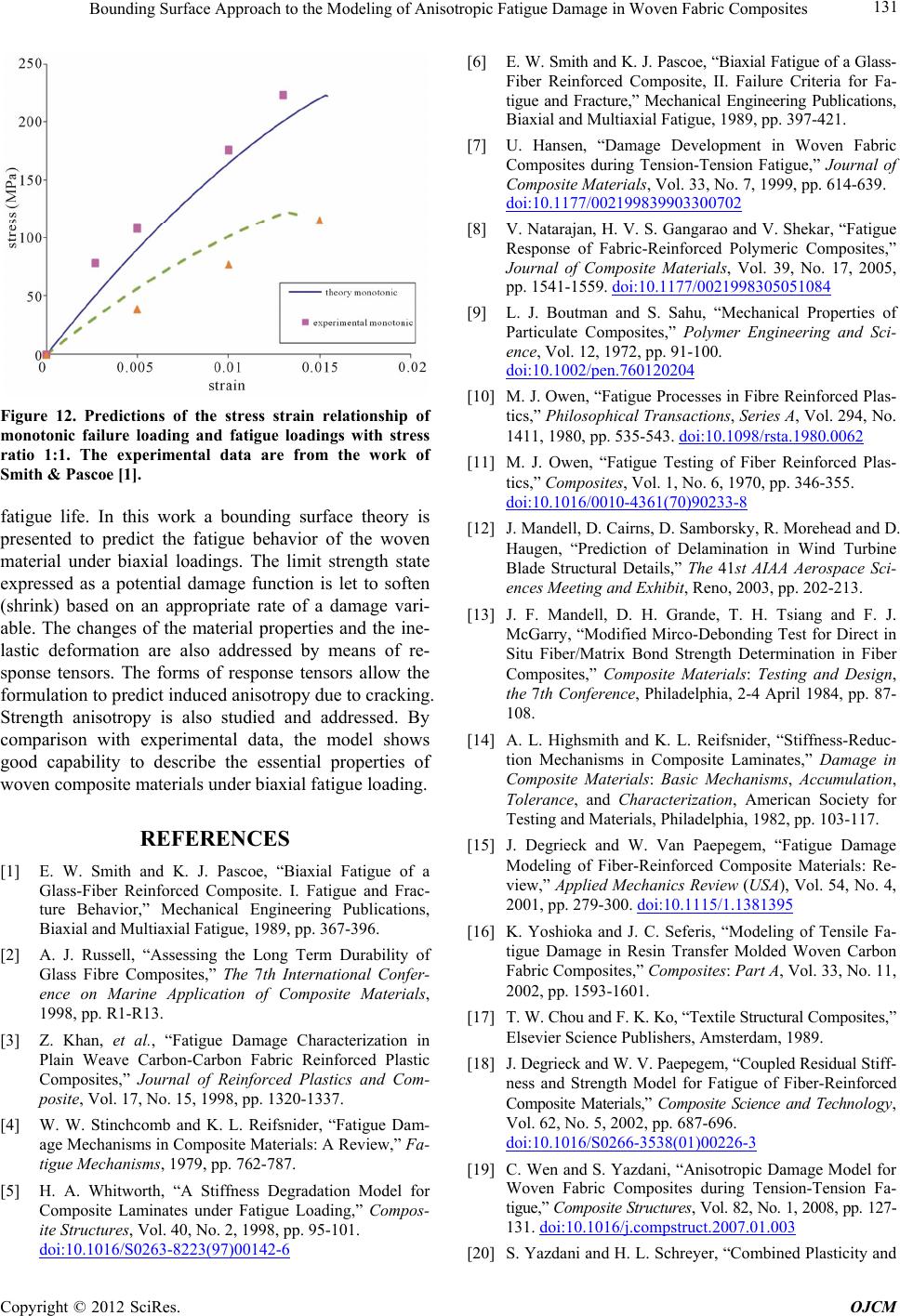
Bounding Surface Approach to the Modeling of Anisotropic Fatigue Damage in Woven Fabric Composites 131
Figure 12. Predictions of the stress strain relationship of
monotonic failure loading and fatigue loadings with stress
ratio 1:1. The experimental data are from the work of
Smith & Pascoe [1].
fatigue life. In this work a bounding surface theory is
presented to predict the fatigue behavior of the woven
material under biaxial loadings. The limit strength state
expressed as a potential damage function is let to soften
(shrink) based on an appropriate rate of a damage vari-
able. The changes of the material properties and the ine-
lastic deformation are also addressed by means of re-
sponse tensors. The forms of response tensors allow the
formulation to predict induced anisotropy due to cracking.
Strength anisotropy is also studied and addressed. By
comparison with experimental data, the model shows
good capability to describe the essential properties of
woven composite materials under biaxial fatigue loading.
REFERENCES
[1] E. W. Smith and K. J. Pascoe, “Biaxial Fatigue of a
Glass-Fiber Reinforced Composite. I. Fatigue and Frac-
ture Behavior,” Mechanical Engineering Publications,
Biaxial and Multiaxial Fatigue, 1989, pp. 367-396.
[2] A. J. Russell, “Assessing the Long Term Durability of
Glass Fibre Composites,” The 7th International Confer-
ence on Marine Application of Composite Materials,
1998, pp. R1-R13.
[3] Z. Khan, et al., “Fatigue Damage Characterization in
Plain Weave Carbon-Carbon Fabric Reinforced Plastic
Composites,” Journal of Reinforced Plastics and Com-
posite, Vol. 17, No. 15, 1998, pp. 1320-1337.
[4] W. W. Stinchcomb and K. L. Reifsnider, “Fatigue Dam-
age Mechanisms in Composite Materials: A Review,” Fa-
tigue Mechanisms, 1979, pp. 762-787.
[5] H. A. Whitworth, “A Stiffness Degradation Model for
Composite Laminates under Fatigue Loading,” Compos-
ite Structures, Vol. 40, No. 2, 1998, pp. 95-101.
doi:10.1016/S0263-8223(97)00142-6
[6] E. W. Smith and K. J. Pascoe, “Biaxial Fatigue of a Glass-
Fiber Reinforced Composite, II. Failure Criteria for Fa-
tigue and Fracture,” Mechanical Engineering Publications,
Biaxial and Multiaxial Fatigue, 1989, pp. 397-421.
[7] U. Hansen, “Damage Development in Woven Fabric
Composites during Tension-Tension Fatigue,” Journal of
Composite Materials, Vol. 33, No. 7, 1999, pp. 614-639.
doi:10.1177/002199839903300702
[8] V. Natarajan, H. V. S. Gangarao and V. Shekar, “Fatigue
Response of Fabric-Reinforced Polymeric Composites,”
Journal of Composite Materials, Vol. 39, No. 17, 2005,
pp. 1541-1559. doi:10.1177/0021998305051084
[9] L. J. Boutman and S. Sahu, “Mechanical Properties of
Particulate Composites,” Polymer Engineering and Sci-
ence, Vol. 12, 1972, pp. 91-100.
doi:10.1002/pen.760120204
[10] M. J. Owen, “Fatigue Processes in Fibre Reinforced Plas-
tics,” Philosophical Transactions, Series A, Vol. 294, No.
1411, 1980, pp. 535-543. doi:10.1098/rsta.1980.0062
[11] M. J. Owen, “Fatigue Testing of Fiber Reinforced Plas-
tics,” Composites, Vol. 1, No. 6, 1970, pp. 346-355.
doi:10.1016/0010-4361(70)90233-8
[12] J. Mandell, D. Cairns, D. Samborsky, R. Morehead and D.
Haugen, “Prediction of Delamination in Wind Turbine
Blade Structural Details,” The 41st AIAA Aerospace Sci-
ences Meeting and Exhibit, Reno, 2003, pp. 202-213.
[13] J. F. Mandell, D. H. Grande, T. H. Tsiang and F. J.
McGarry, “Modified Mirco-Debonding Test for Direct in
Situ Fiber/Matrix Bond Strength Determination in Fiber
Composites,” Composite Materials: Testing and Design,
the 7th Conference, Philadelphia, 2-4 April 1984, pp. 87-
108.
[14] A. L. Highsmith and K. L. Reifsnider, “Stiffness-Reduc-
tion Mechanisms in Composite Laminates,” Damage in
Composite Materials: Basic Mechanisms, Accumulation,
Tolerance, and Characterization, American Society for
Testing and Materials, Philadelphia, 1982, pp. 103-117.
[15] J. Degrieck and W. Van Paepegem, “Fatigue Damage
Modeling of Fiber-Reinforced Composite Materials: Re-
view,” Applied Mechanics Review (USA), Vol. 54, No. 4,
2001, pp. 279-300. doi:10.1115/1.1381395
[16] K. Yoshioka and J. C. Seferis, “Modeling of Tensile Fa-
tigue Damage in Resin Transfer Molded Woven Carbon
Fabric Composites,” Composites: Part A, Vol. 33, No. 11,
2002, pp. 1593-1601.
[17] T. W. Chou and F. K. Ko, “Textile Structural Composites,”
Elsevier Science Publishers, Amsterdam, 1989.
[18] J. Degrieck and W. V. Paepegem, “Coupled Residual Stiff-
ness and Strength Model for Fatigue of Fiber-Reinforced
Composite Materials,” Composite Science and Technology,
Vol. 62, No. 5, 2002, pp. 687-696.
doi:10.1016/S0266-3538(01)00226-3
[19] C. Wen and S. Yazdani, “Anisotropic Damage Model for
Woven Fabric Composites during Tension-Tension Fa-
tigue,” Composite Structures, Vol. 82, No. 1, 2008, pp. 127-
131. doi:10.1016/j.compstruct.2007.01.003
[20] S. Yazdani and H. L. Schreyer, “Combined Plasticity and
Copyright © 2012 SciRes. OJCM